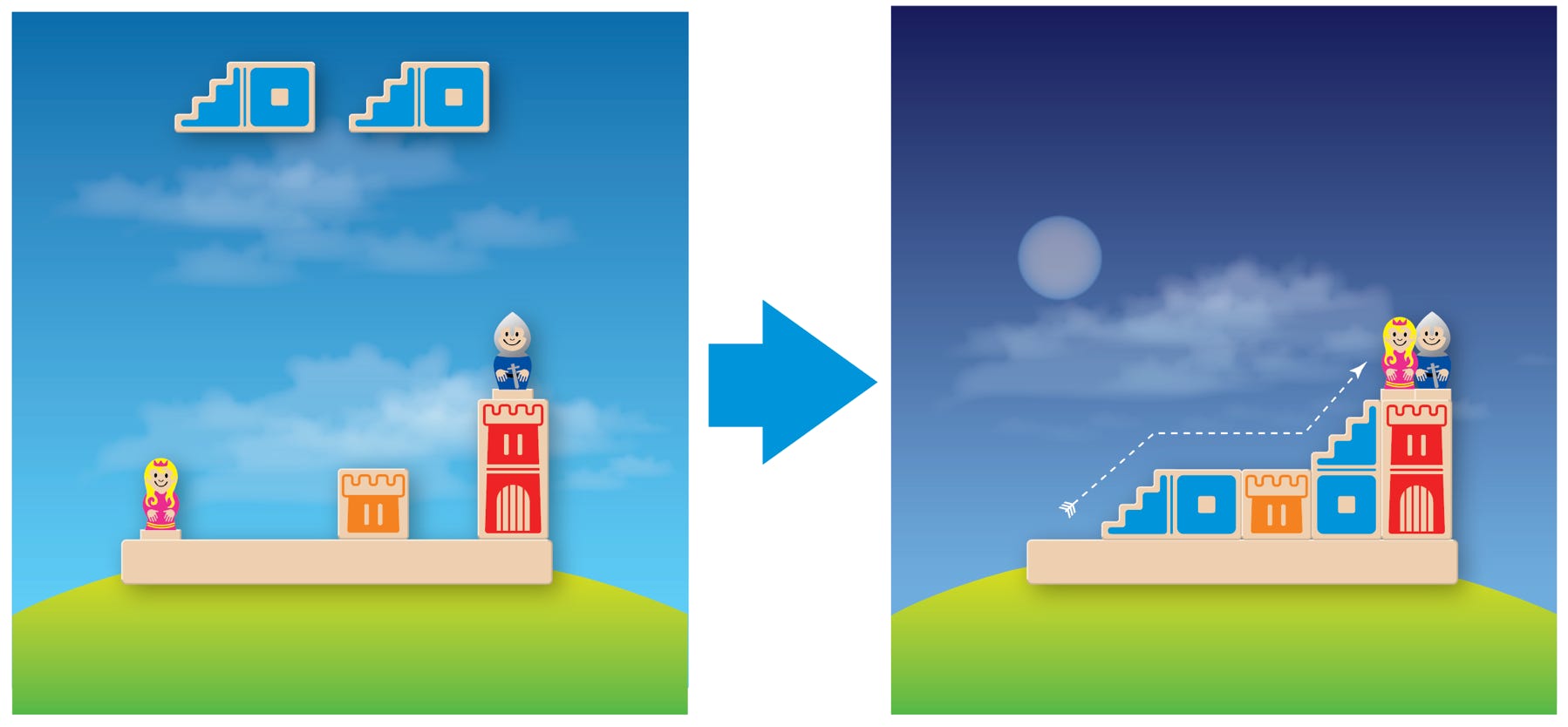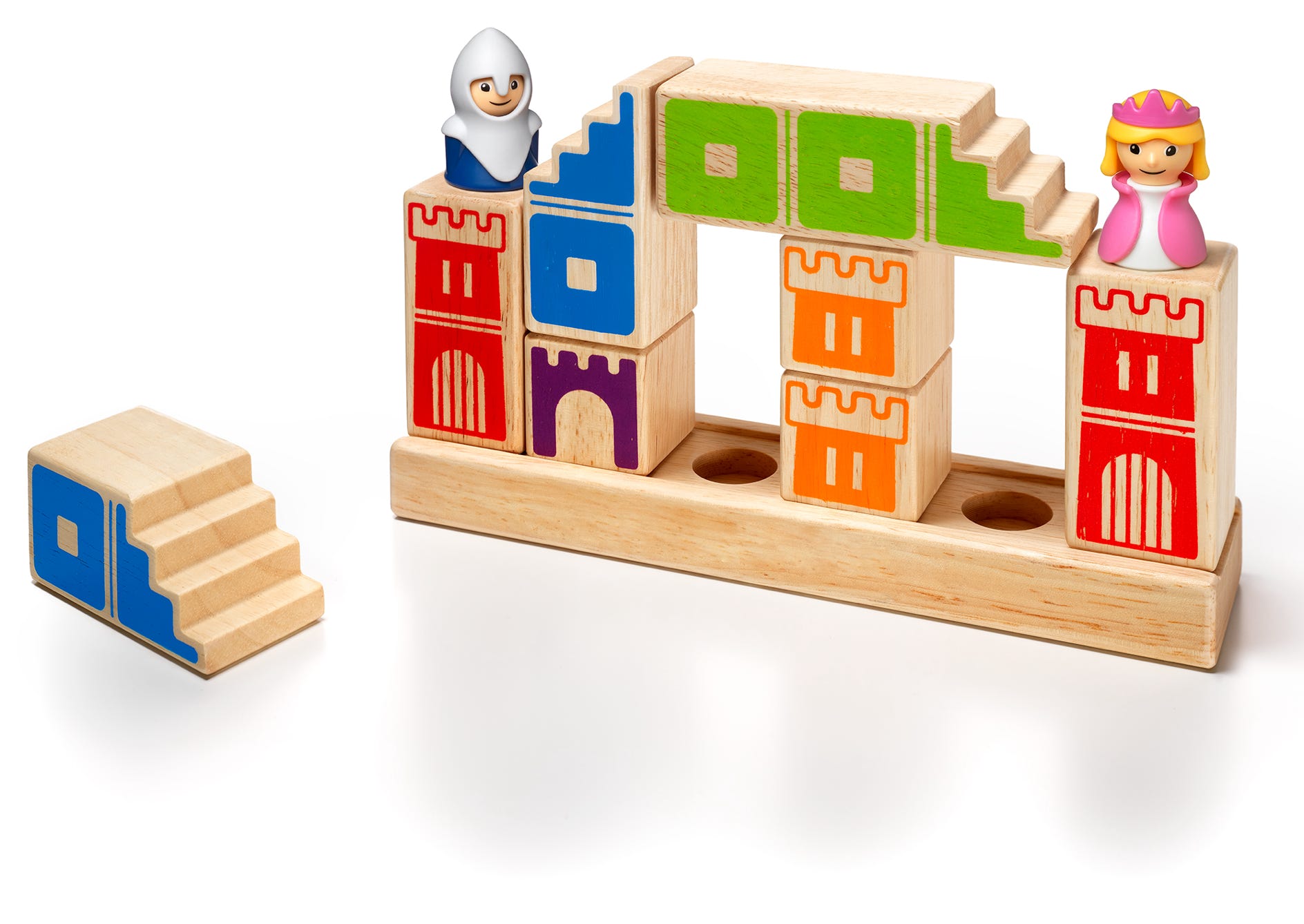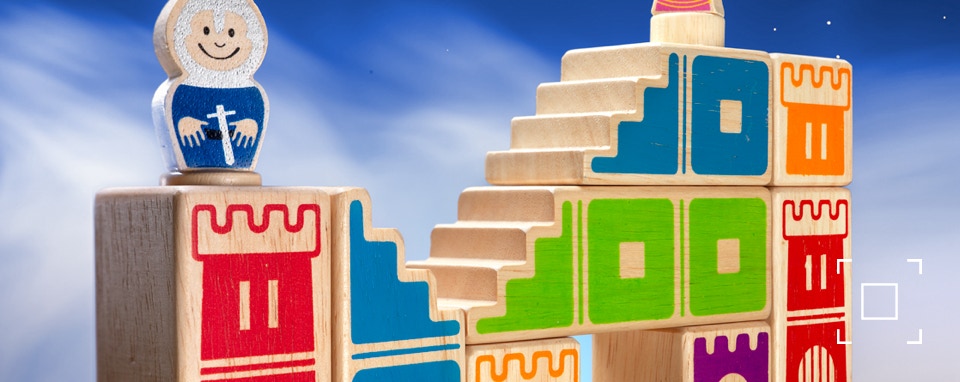
Camelot Jr.
The story behind the creation of Camelot Junior
Raf Peeters, January 2007
“Camelot Junior” is without any doubt my favorite puzzle for kids I designed for Smart Games so far. Probably because it combines a lot of my interests: castles, knights, paths, bridges and objects made of wood.
OBJECT OF THE GAME
Like most of my games, it looks deceptively simple. It's not clear what is invented or designed here. What makes this a great game concept is not what the blocks look like, but which blocks are used in combination with a simple game rule: try to create a path so the princess and the knight can be reunited. The positions of 4 of the blocks (the towers) are given in the challenge, but the player needs to figure out the correct position of the remaining 4 (bridge and stairways) themselves.
LESS IS MORE
It's always possible, of course, to make challenging puzzles with a lot of parts and/or complex game rules. But I try to do the opposite. I started out with 12 blocks, but after experimenting with all kinds of combinations, the result was a game with only 8 blocks. More blocks would not have made the game more interesting, only more expensive. Trying to find the best combination of puzzle pieces and game rules is probably the design element that I like the most. And together with testing out the challenges, it is also the part that takes the most time during the design process.
CHALLENGES AND SOLUTIONS
There are 2 kinds of challenges. For some, it looks like you don't have enough blocks to create a pathway so you need to make a very efficient bridge. These are the kinds of challenges you would expect from a puzzle with just a few parts. But for some challenges, it looks like you have too many blocks, so you have to place the blocks in such a way that you use up the extra wood, without it obstructing the pathway. To solve this kind of challenge, you need to think more creatively.
SAVE THE WORLD
In the first version I did, the blocks featured cross-shaped windows, and the knight always saved the princess. But people in some parts of the world read the windows as being a religious symbol, and people in other parts of the world thought it was not very educational for the girl always waiting to be saved… So the current version of this Camelot game has square windows and in half of the challenges the princess saves the knight. And now everybody is happy, although I don't think this will really have a huge impact on world peace or women’s rights ;-)
If you loved Camelot Junior, you might like other wooden SmartGames for younger kids like Trucky 3 or Bunny Peek A Boo too.
UPDATE 2018
In 2018 we updated Camelot Jr. It now includes two plastic figurines, not because it’s cheaper (it’s not), but because these new figurines are much more stable. I also never liked the “flat” appearance of the wooden figurines that had the same print on both sides, which is kind of weird. The image at the top of this page shows the old version. Below is how the new version looks like.
UPDATE 2024
In 2024 the game will be updated again, going back to an all wood version, but this time with nicer artwork for the figurines than the 2007 version. The new wooden figurines are also more stable than the original ones. I still need to update the images to the most recent version.

example of an easy challenge/solution of Camelot Junior with only 2 stairways

example of an difficult challenge/solution of Camelot Junior where you need to construct a bridge.

GAME RULES CAMELOT JUNIOR
1) Choose a challenge. Place the red and orange towers as indicated. Don’t forget! Where you see a bat you must leave a gap for it in the base of the game.
2) Place the knight and princess in position as directed by your challenge. Use only the blocks shown at the top of the challenge page. Move the remaining blocks out of the way as they must not be used to solve the challenge.
3) Create a path for the knight and his princess to be reunited. All possible solutions can be found on the flipside of each challenge.
IMPORTANT!
Neither the knight nor the princess can be moved until all blocks are in position and the pathway is complete. The knight and princess must be able to walk directly over your construction to reach each other. You must use the exact blocks shown in your challenge, no more and no fewer. The round holes in the towers and the base are not obstacles. They are only used to position the towers correctly. The knight and princess can safely walk over these holes.
A) The knight and princess can only walk up stairways or along the top of walls. They cannot jump down or climb up walls.
B) The stairway cannot be balanced on its narrowest edge as without support it will fall. The stairways may be used standing upright or lying down. They may also be placed upside down to create a level pathway.
C) All blocks must be placed in the ‘squares’ of an imaginary grid with the printed sides facing the player.
D) The final structure must be stable. This means that your construction must stand on its own even if you were to remove supporting blocks from the left and right.
TIPS:
• We strongly recommend players work through the challenges in the sequence given in the game guide; otherwise important ‘learning steps’ may get missed.
• If a challenge seems too hard, turn to the solution and try working backwards from there. Looking at the solution children learn new building techniques helping them understand.
Website ©2007 Raf Peeters
Products and images: © Smart
